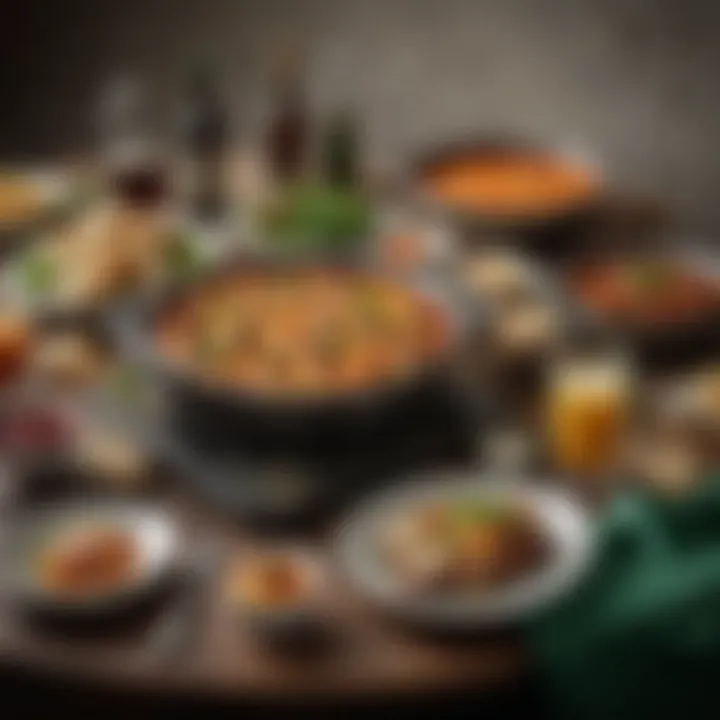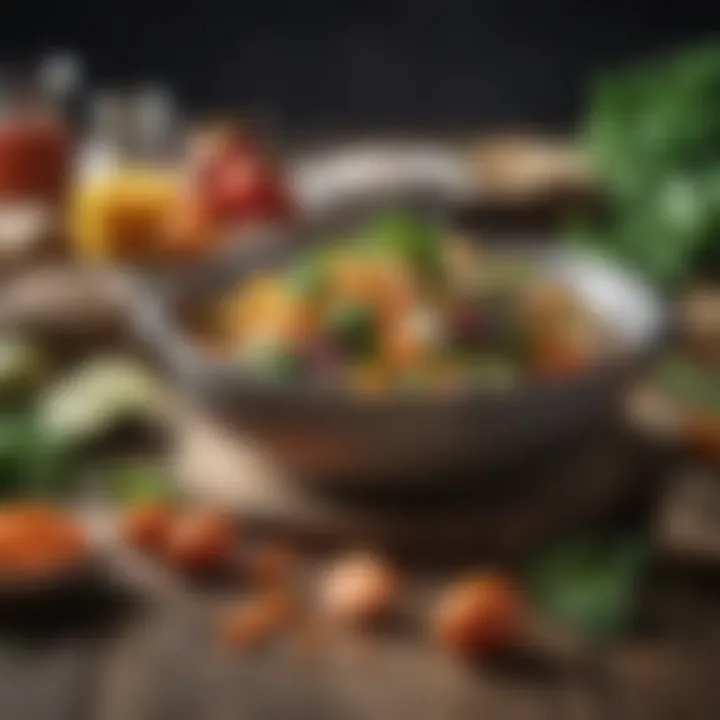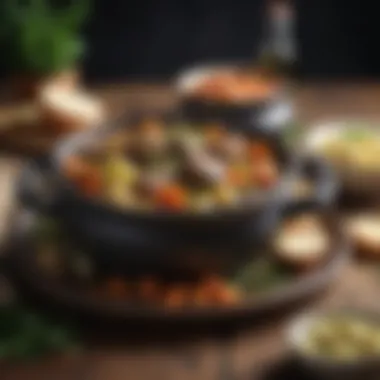Savoring St. Patrick's Day: Culinary Traditions & Recipes


Intro
St. Patrick's Day has evolved into a celebration of Irish culture, encompassing not just parades and music, but also a rich culinary tradition. This day offers a unique opportunity to explore dishes that embody the essence of Ireland’s history and flavors. Understanding what to cook and why certain ingredients are integral can enhance any feast.
This guide examines the culinary aspects associated with St. Patrick's Day. We will uncover the historical background of several dishes and how they have transformed over time. Additionally, readers will find practical recipes that cater to various skill levels—whether you are a home cook just starting or an experienced chef wishing to explore new ideas.
By diving into ingredient selection and practical cooking techniques, this article aims to elevate the culinary experience. This journey through Irish cuisine will foster a greater appreciation of the holiday's heritage, giving you a deeper connection to each meal served on this festive day.
Recipe Overview
Classic Irish Stew
Description of the Dish
Irish stew is a traditional dish that showcases the heartiness of Irish cooking. It generally consists of lamb or beef, potatoes, carrots, and onions—creating a warm and comforting meal that many associate with St. Patrick's Day. This stew is not just a practical dish for using leftover meat; it represents the resourcefulness of Irish households throughout history.
Ingredients
List of Ingredients with Measurements
- 1.5 lbs of lamb or beef, cut into chunks
- 4 medium potatoes, peeled and chopped
- 3 carrots, sliced
- 2 medium onions, chopped
- 4 cups beef or vegetable broth
- 2 tbsp olive oil
- Salt and pepper to taste
- Fresh parsley for garnish
Special Notes on Ingredients
- For a vegetarian version, substitute meat with mushrooms, lentils, or chickpeas.
- Note the choice of meat can vary by region; some areas prefer beef while others favor lamb for a richer flavor.
"Cooking with tradition in mind deepens the flavor of each dish and connects us with our shared heritage."
As this exploration continues, you can delve into more recipes and variations that highlight the culinary diversity of Ireland. The blend of ingredients reflects not only regional preferences but also the changing seasons and availability. This connection to the past is what makes St. Patrick’s Day cooking so significant.
St. Patrick's Day: A Cultural Context
Understanding the cultural context of St. Patrick's Day is essential to fully appreciate its culinary traditions. The day celebrates Ireland's patron saint, St. Patrick, who is credited with bringing Christianity to the island. This event has evolved over centuries from a religious observance into a global celebration of Irish culture and heritage.
The Origins of St. Patrick's Day
St. Patrick's Day has roots stretching back to the 17th century when it was declared a feast day. Originally, this day was observed with masses and solemnity. St. Patrick is known for his missionary work and for using the shamrock to explain the Holy Trinity to the Irish people. Many aspects of the celebrations have adapted over time, reflecting changes in society and cultural perceptions. From humble beginnings, the day began to represent not only the religious significance but also the cultural pride of Irish nationals and diaspora.
As Irish immigrants settled in various parts of the world, especially in the United States, they maintained their customs and culinary traditions. This led to the adaptation of the holiday, which is now synonymous with parades, music, and a shared sense of identity among people of Irish descent. The rise of global awareness around this holiday has contributed to its transformation into a day to celebrate not just St. Patrick, but also all things Irish.
Traditions and Festivities
Traditions associated with St. Patrick's Day highlight Irish customs and reflect a sense of pride. These customs include wearing green clothing, which symbolizes the lush landscapes of Ireland and is also linked to the shamrock. Celebratory feasts play a crucial role, showcasing traditional dishes like corned beef and cabbage.
Festivities often involve public parades, festivals, and music. Cities worldwide have embraced these celebrations, resulting in large gatherings filled with dance and song. In addition to the culinary aspects, several beverages with Irish connections are consumed, such as Guinness and Irish whiskey, enriching the experience for those participating in the events.
Understanding these cultural elements not only enhances the culinary exploration of St. Patrick's Day but also instills a deeper appreciation for its significance within Irish and global contexts. Through food, people connect to the past and celebrate a unique cultural identity.
The Culinary Landscape of Ireland
The culinary landscape of Ireland serves as a vital backdrop for understanding St. Patrick's Day cooking. Known for its rich history, this landscape highlights the country’s unique blend of local ingredients and cultural traditions. In this section, we will explore traditional Irish ingredients and regional cooking variations. This exploration not only gives insight into what makes Irish cuisine special but also informs how these elements enhance celebrations like St. Patrick's Day.
Traditional Irish Ingredients
Potatoes
Potatoes are often hailed as the cornerstone of Irish cooking. Introduced in the late 16th century, they adapted well to the Irish climate and became a staple food. Potatoes are versatile and can be prepared in many ways, such as mashed, fried, or baked. Their hearty nature makes them a popular choice for various dishes associated with St. Patrick's Day. However, they can transform easily from a fulfilling side dish to the basic element of a main course, particularly in recipes like Colcannon.
One unique feature of potatoes is their ability to absorb flavors from surrounding ingredients, thus enhancing the overall dish. Yet, a downside could be their heavy starchy content, which may not fit every dietary preference.
Soda Bread
Irish Soda Bread is another essential ingredient that holds cultural significance. Made with baking soda instead of yeast, it is quick to prepare and can be a great accompaniment to many meals. Its dense texture and slightly tangy flavor profile make it a versatile partner for savory and sweet dishes alike. Soda Bread fits well within a St. Patrick's Day feast as it can easily soak up gravies and broths, making it an invaluable option.
The unique feature lies in its simplicity and the use of basic ingredients. While it may limit variety in terms of flavor compared to yeast-leavened bread, the straightforward preparation allows even novice cooks to create it.
Seafood
Seafood also plays an integral role in the Irish culinary narrative. The proximity of Ireland to the Atlantic Ocean provides a wide array of fresh fish and seafood. Dishes like fish stew or grilled salmon can often feature in St. Patrick's Day menus, showcasing the bounty of Irish waters.
One key characteristic of seafood is its freshness, which contributes to a clean, bright flavor in dishes. Including seafood can also highlight healthy eating, appealing to modern dietary considerations. However, sourcing quality seafood can sometimes be a challenge, depending on location and season.


Meat Cuts
When discussing traditional Irish meals, meat cuts cannot be overlooked. Lamb and beef are especially popular and can often take center stage on St. Patrick’s Day. Dishes like Beef and Guinness Stew exemplify how local meats can be cherished in comfort foods. These cuts provide rich flavors and textures, making the dishes deeply satisfying.
What sets meat cuts apart is their ability to bring familiarity and heartiness to a meal. While they do present some considerations in terms of preparation and cooking time, the variety available can cater to different cooking styles and preferences.
Regional Variations in Irish Cooking
The Influence of Geography
Ireland's geographical diversity greatly influences its regional cooking styles. From coastal regions that favor seafood to inland areas where livestock farming prevails, geography shapes what ingredients are available and how they are used. Each region boasts distinctive flavors that reflect the local produce and traditions.
The unique characteristic here is how geography informs local diets. A downside is that not all regions may have equal access to various ingredients, which can limit culinary options.
Celtic Cooking Styles
Celtic cooking styles also add depth to the Irish culinary experience. Influenced by ancient traditions, they embrace seasonal ingredients and communal cooking methods. Often, recipes encourage sharing, which fits well with festive occasions like St. Patrick's Day.
This community focus is a crucial aspect, making dishes more than just sustenance. Yet, as these styles can be quite traditional, they may not always align with modern dietary trends.
Modern Adaptations
Modern adaptations of Irish cuisine are reshaping traditional practices. Many chefs are infusing contemporary techniques and international flavors into Irish recipes, making them more accessible to a wider audience. For example, vegetarian versions of traditional meat dishes are increasingly popular, providing options for multiple dietary needs.
What stands out in these modern adaptations is the innovation that maintains cultural essence. However, this evolution may lead to debates about authenticity, which can spark diverse opinions among food enthusiasts.
St. Patrick's Day Dishes: An Overview
St. Patrick's Day represents a unique opportunity to explore Irish culinary traditions through its dishes. The dishes served on this day are not just food; they carry cultural significance and reflect the heritage of Ireland. Many of these classic meals are rich in history and local ingredients, making them important to any culinary exploration focused on the holiday.
By preparing traditional meals, one creates a connection not only to the culinary practices but also to celebrations that have persisted through generations. Incorporating these dishes into your feast helps honor the occasion while stimulating a genuine appreciation for Irish food culture. The recipes presented offer a range of flavors, textures, and preparation styles that embody the spirit of St. Patrick's Day.
Classic Dishes Associated with the Holiday
Colcannon
Colcannon is a blend of mashed potatoes mixed with greens like cabbage or kale. Its creamy consistency and hearty nature make it a standout dish. The dish is significant for its simplicity and ease of preparation. Often served as a side, Colcannon carries the comfort of home-cooked meals and embodies the richness of Irish farming traditions.
Its unique feature is the integration of seasonal greens, which adds both flavor and nutrition. This character makes it a popular choice for St. Patrick's Day celebrations, resonating with families for generations. Although sometimes viewed as less glamorous than other dishes, its humble roots demand respect and reflect a culinary style centered on utilizing available ingredients effectively.
Rasher and Cabbage
Rasher and Cabbage is a quintessential Irish dish consisting of fried bacon, known as rasher in Ireland, served alongside cooked cabbage. This dish captures the essence of traditional Irish cooking, emphasizing the importance of pork as a staple meat. Its salty flavor contrasts nicely with the mildness of cabbage, making it appealing on various palates.
What sets Rasher and Cabbage apart is its straightforward preparation, requiring just a few ingredients. This makes it a venue for leisurely family meals during St. Patrick’s Day. While some might find it a basic dish, it resonates with those who appreciate comfort and simplicity over sophistication, reminding them of home.
Beef and Guinness Stew
Beef and Guinness Stew is a robust dish made with tender chunks of beef braised in stout. The rich dark Guinness beer not only tenderizes the meat but also adds complex flavors to the broth. This dish is emblematic of hearty Irish fare, perfect for cold weather and festive gatherings. Its warm, inviting aroma greets guests, making it a crucial element of St. Patrick's Day meals.
The uniqueness of Beef and Guinness Stew lies in its depth of flavor, which develops through slow cooking. This characteristic makes it a favorited selection among many, as it allows for meal prep ahead of time, offering ease during the busy holiday. Though it may require a bit more time to prepare, the end product yields a warming comfort that is representative of Irish hospitality.
The Role of Soda Bread
Soda bread plays a foundational role in Irish cooking, specifically during St. Patrick's Day. It is a quick bread made using baking soda as a leavening agent, rather than yeast. This fast preparation method caters well to busy kitchens, especially on festive days.
Soda bread is often served with many traditional dishes. Its simple ingredients allow it to complement various meals while retaining its distinctive flavor. The crispy crust and soft interior are qualities appreciated by many. Adding ingredients like raisins or caraway seeds offers variations, enhancing its appeal for different tastes.
Exploring Irish Desserts
Bread Pudding
Bread pudding is a dessert made from leftover bread soaked in a custard mixture and baked. This humble dish turns uneaten bread into a delicious sweet treat. Its resourcefulness aligns perfectly with the spirit of St. Patrick's Day, emphasizing waste reduction. Bread pudding can easily adapt to include local flavors, making it a great addition to celebrations.
Its key characteristic is its versatility; it can be served warm or chilled and dressed with sauces or fruits. This adaptability makes it a beneficial option for various preferences and dietary needs during the holiday.
Shamrock Shakes
Shamrock Shakes are a celebratory drink mint-flavored, often associated with March festivities. Their bright green hue embodies the theme of St. Patrick's Day. Usually made with ice cream and mint extract, these shakes offer a fun and festive approach to dessert.
Their uniqueness lies in their visual appeal and the nostalgic connection many have to the seasonal treat. While they compliment a festive menu, the sugar richness may not suit all dietary preferences, making them less ideal for some.


Irish Brownies
Irish Brownies are a rich dessert that combines chocolate and Irish ingredients like whiskey. Their fudgy texture and deep flavor provide a delightful conclusion to a St. Patrick's Day meal. Brownies add a touch of indulgence to the celebration, appealing to chocolate lovers everywhere.
The use of whiskey offers a unique twist, enhancing the flavor profile and making the dessert memorable. While they may offer excitement, their richness also means moderation is key, as some may find them overly sweet compared to more traditional options.
The consideration of traditional dishes allows for a greater appreciation of Irish culinary practices during St. Patrick's Day, contributing to the legacy of a culture that prizes hospitality.
Cooking Techniques for St. Patrick's Day
Cooking techniques play a crucial role in celebrating St. Patrick's Day, especially when it comes to preparing traditional Irish dishes. Understanding these methods can enhance the holiday's culinary experience. Mastering specific cooking techniques allows both novice and experienced cooks to more effectively prepare authentic flavors that define Irish cuisine.
Slow cooking, baking bread, and effectively using herbs and spices are three essential techniques that come into play during this festive occasion. Each method serves a distinct purpose and offers various benefits. Slow cooking nurtures deep flavors, while baking allows traditional bread recipes to shine. Proper use of herbs and spices can transform any dish into an experience filled with character.
Understanding Slow Cooking
Slow cooking is a method that supports the development of rich flavors over an extended period. It is particularly well-suited for dishes like Beef and Guinness Stew, where the meat benefits from the gentle simmering process. This technique allows tougher cuts of meat to become tender and absorb flavors from other ingredients.
The advantages of slow cooking are clear. It requires minimal input after the initial preparation, allowing the cook to attend to other aspects of meal planning without constant supervision. Furthermore, this technique is ideal for larger gatherings on St. Patrick's Day, as dishes can be prepared in advance and kept warm until serving.
Mastering Baking for Irish Soda Bread
Baking Irish soda bread is an integral part of many St. Patrick's Day celebrations. This bread, which relies on baking soda as a leavening agent rather than yeast, is quick to prepare and offers a unique flavor profile. With a few simple ingredients, one can create a loaf that complements a variety of Irish meals.
It is worth mentioning that mastering the correct technique is essential for achieving the perfect texture. Under-mixing the dough can result in a dense bread, while over-mixing can make it tough. A light touch is essential for developing the desired crumb without sacrificing the bread's characteristic tenderness.
Effective Use of Herbs and Spices
Herbs and spices are fundamental in enhancing Irish dishes, bringing balance and depth to recipes. Understanding their effective use can elevate a standard dish into something remarkable. Key herbs like parsley, thyme, and dill are commonly found in Irish cooking, serving both flavor and aesthetic purposes.
Commonly Used Herbs
Using commonly utilized herbs like parsley adds freshness to many Irish recipes. Parsley, for example, not only brightens the flavors but also contributes a beautiful green color, making dishes visually appealing. Its versatility is unmatched, making it a beneficial choice in a variety of contexts. Moreover, parsley is accessible and can be found in most kitchens.
However, one must be cautious; using too much can overpower subtle flavors, diminishing the overall experience of a dish.
Balancing Flavors
Balancing flavors is a principle that can transform an ordinary meal into a culinary masterpiece. Each component of a dish must enhance and complement the others. For instance, a touch of acidity can brighten the richness of cream-based dishes often found in Irish cooking. Achieving this balance is a key characteristic of skilled cooking.
This technique's unique feature involves not just flavor addition, but its ability to unify all ingredients. Ignoring this principle can lead to an unevenly flavored dish. Therefore, cooks should always taste and adjust as they go, ensuring a harmonious end result.
"Cooking is all about balance. Find it, and you can create magic."
Modern Takes on Irish Cuisine for St. Patrick's Day
Embracing modern takes on Irish cuisine for St. Patrick's Day has become a significant trend. This evolution demonstrates how traditional recipes can be adapted for today's diverse dietary preferences and lifestyles. With increased awareness of health and sustainability, cooks are looking for ways to make classic dishes more innovative and inclusive. It highlights creativity while respecting the rich culinary heritage. These modern interpretations often cater to a wider audience, ensuring that everyone can partake in celebrating the holiday.
Innovative Recipes
Vegetarian Irish Stew
Vegetarian Irish stew presents a unique approach to a traditional staple. This dish retains the comforting essence of the classic while omitting meat, making it appealing to vegetarians and those looking to cut back on meat consumption. The key characteristic is that it utilizes hearty vegetables such as carrots, potatoes, and parsnips, often simmered with rich vegetable broth. This creates a flavorful depth akin to the traditional stew but with a fresh, plant-based twist.
The main advantage of vegetarian Irish stew is its adaptability. It can be modified with various seasonal vegetables. However, one could argue that it may lack the robust flavor that some associate with a meat-based stew. Despite this, the inclusion of herbs and spices can enhance its taste dramatically.
Gourmet Soda Bread Variations
Gourmet soda bread variations are another modern twist worth exploring. While traditional soda bread is simple and rustic, innovative recipes incorporate ingredients such as nuts, fruits, or specialty flours. This elevates the humble bread into a gourmet item suitable for upscale gatherings or casual family dinners.
The essential feature of gourmet soda bread is its versatility. The introduction of unique flavors can make it a discussion piece at any meal. These variations provide a chance to experiment and redefine perceptions of soda bread. However, some may argue that this could strays too far from tradition. Nevertheless, the ability to cater to different tastes is a key benefit that allows for a broader appeal.
Healthy Alternatives
Low-Calorie Versions of Traditional Dishes
Low-calorie versions of traditional dishes offer a way to enjoy beloved recipes without unnecessary guilt. These approaches often result in lighter meals that maintain the essence of the original while reducing calorie intake through ingredient substitutions and cooking methods. This makes them a popular choice for those mindful of their health.
A common feature is substituting higher-calorie ingredients with lighter options, such as using Greek yogurt instead of cream. One advantage is the ability to enjoy traditional flavors without compromising health goals. On the downside, some might find these versions less satisfying compared to their full-calorie counterparts, but with careful seasoning, they can be quite flavorful.
Gluten-Free Options


Gluten-free options are essential in today’s culinary world, especially for those with gluten sensitivities or celiac disease. The inclusion of gluten-free versions of traditional Irish foods, such as soda bread or shepherd’s pie, means that more individuals can partake in holiday meals without concern for their health.
The core characteristic of these dishes is that they use alternative flours such as almond or coconut flour. These not only cater to dietary restrictions but can also introduce interesting flavors. A potential drawback is that gluten-free baked goods can sometimes have a different texture and might not rise as much. Despite this, the effort to inclusively prepare meals demonstrates thoughtfulness toward guests' dietary needs.
"Exploring modern interpretations of traditional dishes is not about losing heritage; it is about evolving with it."
Presenting St. Patrick's Day Meals
St. Patrick's Day is not only about the flavors and cooking techniques but also about how the meals are presented. The way a dish looks can enhance the dining experience and contribute to the festive atmosphere of the holiday. A well-presented meal can elevate traditional dishes, making them feel special and inviting. Careful attention to plating can also show respect for the ingredients and the cultural heritage behind the dishes. Moreover, a visually appealing meal can encourage conversation and enjoyment among guests, blending the culinary with the communal.
Plating Techniques for Festive Occasions
Using distinct plating techniques can make the dishes for St. Patrick's Day more enticing. Color contrast is essential; greens, browns, and golds should blend in harmony. Arranging food into distinct shapes or piles can guide the eyes and lead to a more engaging presentation. One popular method is to use a ring mold, which allows for stacking layers neatly, enhancing textural dimension. Garnishing with fresh herbs or edible flowers can add a touch of elegance. Creative use of space on the plate can also emphasize portions, making sure each element has its own place.
Pairing Beverages with Dishes
Classic Irish Drinks
Classic Irish drinks have a significant role during St. Patrick's Day meals. Beverages like Guinness, Irish whiskey, and Irish cream cocktails are commonly served. These beverages are not only rich in flavor but also contribute to the cultural narrative of the holiday. For example, Guinness is a symbol of Irish brewing tradition, and its dark color contrasts beautifully with the vibrant greens of traditional dishes. When paired properly, these drinks can enhance the overall flavor experience of the meal. However, it is important to consider the balance; some drinks may overpower the food, while others will complement it perfectly.
Modern Cocktails
Modern cocktails offer an innovative twist to the traditional St. Patrick's Day festivities. They combine traditional flavors with contemporary mixology techniques. For example, cocktails might include fresh, local ingredients like herbs, citrus, or seasonal fruits, creating a refreshing balance against hearty Irish dishes. A key characteristic of these cocktails is their versatility; they adapt to a wide range of flavors. However, it is important to ensure they are still whiting the spirit of the holiday. One challenge with modern cocktails is finding that balance between creativity and homage to traditional flavors. Making this connection is pivotal for appealing to a wide audience during the celebration.
Sustainability in St. Patrick's Day Cooking
Sustainability plays an increasingly critical role in culinary practices, affecting how we source, prepare, and serve food. As we celebrate St. Patrick's Day, considering sustainable cooking is essential for several reasons. It not only contributes to environmental preservation but also supports local economies and promotes healthy eating habits. By focusing on sustainability, cooks can ensure that the traditions of Irish cuisine are maintained without compromising future generations’ ability to enjoy these culinary delights.
One important element of sustainable cooking is the emphasis on using ingredients that are fresh and locally sourced. This approach not only enhances the quality of the dishes but also reduces the carbon footprint associated with food transportation. Additionally, using locally sourced ingredients often means that they are in season and therefore more flavorful.
Locally Sourced Ingredients
When it comes to St. Patrick's Day cooking, using locally sourced ingredients is vital. This practice helps in creating a connection between the food and its cultural roots. With a focus on what is available in the local area, cooks can incorporate traditional Irish ingredients that celebrate the holiday. For instance, using potatoes from local farms or fish caught in nearby waters helps to preserve the unique flavors of Irish cuisine.
Some benefits of incorporating locally sourced ingredients include:
- Freshness: Ingredients that are sourced locally usually have a shorter time from farm to table. This ensures they retain their nutritional value and flavor.
- Support for Local Farmers: By choosing local products, cooks support farmers and vendors in their community, fostering a sustainable local economy.
- Seasonal Efficiency: Local sourcing encourages the use of ingredients that are in season, which often leads to less resource-intensive and more flavorful meal preparation.
Waste Reduction Strategies
Reducing waste is another crucial aspect of sustainability in St. Patrick's Day cooking. By planning meals carefully, cooks can minimize food waste, which represents a significant challenge in food sustainability.
Some effective waste reduction strategies include:
- Meal Planning: By organizing meals in advance, cooks can buy only what they need. This reduces the likelihood of leftover ingredients that may go bad.
- Using Leftovers Creatively: Leftover ingredients can be repurposed into new dishes. For instance, remnants of corned beef can be transformed into a flavorful hash the next day.
- Composting: Any vegetable scraps or unused food can be composted instead of thrown away. This practice not only reduces landfill waste but also enriches the soil.
"Sustainability in cooking is not just a trend; it is a necessary approach to ensure that future generations can enjoy the flavors we cherish today."
In embracing sustainability during St. Patrick's Day, cooks can honor the holiday and its culinary heritage while promoting responsible and thoughtful eating. This not only enriches the cooking experience but also aligns with conscious consumption, benefiting the community and the environment.
Final Thoughts on St. Patrick's Day Cooking
The exploration of St. Patrick's Day cooking offers insights into the rich tapestry of Irish culinary heritage. This holiday is not just about celebrating Irish culture, but also about remembering and rediscovering the traditions that hold significance. Understanding the history behind each dish brings depth to the cooking experience. Recipes such as colcannon and beef and Guinness stew have local roots but tell expansive stories of the people who prepared them and their impact over time.
Embracing these traditions allows one to connect on a deeper level with the history of Ireland. Engaging with St. Patrick's Day cuisine serves as a gateway to appreciating the importance of seasonal ingredients and local sourcing, which are vital to sustainable cooking practices. Additionally, contemplating modern interpretations of traditional dishes demonstrates the evolution of tastes over generations. It also highlights how food can bridge gaps between cultures, benefiting everyone involved.
Embracing Culinary Heritage
Culinary heritage plays an essential role in shaping identity; St. Patrick's Day cooking is a prime example. When preparing Irish dishes, one connects with ancestors who first made these recipes in their homes. Cuisine goes beyond sustenance. It carries memories, traditions, and familial bonds. Incorporating practices like slow cooking and using seasonal vegetables shapes the flavor profile while being mindful of the past.
Taking time to prepare a meal from scratch fosters appreciation for the ingredients and the effort it requires. Choosing locally sourced foods not only supports regional farmers but also ensures that flavors remain authentic and vibrant. This connection to local ingredients honors the land and the traditions that come with it.
Benefits of Embracing Culinary Heritage
- Fosters a connection between past and present
- Encourages gratitude for both food and its origins
- Highlights the importance of seasonal, local ingredients
- Contributes to sustainable cooking practices
Influence of St. Patrick's Day on Global Cuisine
St. Patrick's Day has transcended its Irish origins to become a worldwide celebration of culture, gastronomy, and community. This holiday promotes the exploration of Irish dishes far beyond Ireland's borders. The festivities inspire chefs and home cooks alike to experiment with flavors, infusing their own culinary traditions into Irish recipes. This integration creates hybrids that reflect a melting pot of influences.
Such adaptations often make traditional dishes more accessible and appealing to diverse palates. For instance, the classic shepherd's pie has seen modern twists incorporating international flavors, transforming it into a culinary diary of sorts, capturing different heritages.
The influence of St. Patrick's Day on global cuisine highlights several key concepts:
- Cultural Exchange: Food becomes a medium through which cultures converse, expanding culinary boundaries.
- Adaptations by Chefs: Restaurants worldwide create novelty dishes inspired by Irish classics, showcasing adaptability and creativity.
- Elevation and Recognition: Irish cuisine gains visibility, inviting enthusiasts to explore its depth and authenticity.
"Food is a universal language, and through St. Patrick's Day cooking, we celebrate not just Irish culture, but the bonds we build through sharing and creativity."







